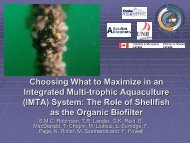Integrated multi-trophic aquaculture (IMTA) in marine temperate waters
Integrated multi-trophic aquaculture (IMTA) in marine temperate waters
Integrated multi-trophic aquaculture (IMTA) in marine temperate waters
You also want an ePaper? Increase the reach of your titles
YUMPU automatically turns print PDFs into web optimized ePapers that Google loves.
<strong>Integrated</strong> <strong>multi</strong>-<strong>trophic</strong> <strong>aquaculture</strong> (<strong>IMTA</strong>) <strong>in</strong> mar<strong>in</strong>e <strong>temperate</strong> <strong>waters</strong> 39<br />
the carriage!). R&D should be conducted <strong>in</strong> a scientific manner to obta<strong>in</strong> and keep<br />
credibility and validity. If not properly carried out, it could lead to questionable data,<br />
unfounded speculations and biased conclusions. Consequently, one has to recognize<br />
that R&D is a full component of any economic development plan. One should<br />
also not forget that R&D is only justified if a “C” (commercialisation) comes next;<br />
unfortunately, there is frequently a major gap between R&D and C, often because the<br />
appropriate fund<strong>in</strong>g structures and <strong>in</strong>centives are not <strong>in</strong> place to take a R&D project<br />
to a C reality.<br />
One must also understand that the performance evaluation of <strong>IMTA</strong> systems requires<br />
a different approach from the typical l<strong>in</strong>ear growth models used for monoculture over<br />
the last decades, without consideration of the environmental and social costs. Five-year<br />
profitability models, with the goal of reach<strong>in</strong>g maximal performance for each cultured<br />
species <strong>in</strong> isolation, should be replaced by optimized, long-term and susta<strong>in</strong>able bioeconomic<br />
models <strong>in</strong> which the yield per unit resource <strong>in</strong>put is evaluated.<br />
F<strong>in</strong>ally, let us not forget that we are still <strong>in</strong> the <strong>in</strong>fancy of modern <strong>in</strong>tensive<br />
<strong>aquaculture</strong> and that some agricultural practices have taken centuries to develop <strong>in</strong>to<br />
better, not yet best, management practices.<br />
CONCLUSIONS AND RECOMMENDATIONS<br />
The <strong>aquaculture</strong> ecological, eng<strong>in</strong>eer<strong>in</strong>g, economic and social challenges rema<strong>in</strong><strong>in</strong>g to<br />
be solved are for some maybe daunt<strong>in</strong>g. However, the goal is to develop modern <strong>IMTA</strong><br />
systems, which are bound to play a major role worldwide <strong>in</strong> susta<strong>in</strong>able expansions<br />
of the <strong>aquaculture</strong> operations of tomorrow, with<strong>in</strong> a balanced ecosystem approach, to<br />
respond to a worldwide <strong>in</strong>creas<strong>in</strong>g seafood demand with a new paradigm <strong>in</strong> the design<br />
of the most efficient food production systems.<br />
Most of the countries with coastl<strong>in</strong>es <strong>in</strong> <strong>temperate</strong> regions of the globe have some level<br />
of <strong>aquaculture</strong> ongo<strong>in</strong>g, although very few, with the exception of Canada, Chile, South<br />
Africa, the United K<strong>in</strong>gdom, Ireland, the United States of America and Ch<strong>in</strong>a, have<br />
ongo<strong>in</strong>g <strong>IMTA</strong> systems near or at commercial scale. <strong>IMTA</strong> has enormous potential for<br />
growth <strong>in</strong> all the countries discussed. Several countries have active research programs<br />
ga<strong>in</strong><strong>in</strong>g knowledge about their regions potential for development of <strong>IMTA</strong>, while other<br />
countries have made no direct groundwork toward the development of <strong>IMTA</strong>.<br />
Genera of particular <strong>in</strong>terest and those with high potential for development <strong>in</strong><br />
<strong>IMTA</strong> systems <strong>in</strong> mar<strong>in</strong>e <strong>temperate</strong> <strong>waters</strong> <strong>in</strong>clude:<br />
- Lam<strong>in</strong>aria, Sacchar<strong>in</strong>a, Sacchoriza, Undaria, Alaria, Ecklonia, Lessonia, Durvillaea,<br />
Macrocystis, Gigart<strong>in</strong>a, Sarcothalia, Chondracanthus, Callophyllis, Gracilaria,<br />
Gracilariopsis, Porphyra, Chondrus, Palmaria, Asparagopsis and Ulva (seaweeds),<br />
- Haliotis, Crassostrea, Pecten, Argopecten, Placopecten, Mytilus, Choromytilus and<br />
Tapes (molluscs),<br />
- Strongylocentrotus, Paracentrotus, Psammech<strong>in</strong>us, Loxech<strong>in</strong>us, Cucumaria, Holothuria,<br />
Stichopus, Parastichopus, Apostichopus and Athyonidium (ech<strong>in</strong>oderms),<br />
- Nereis, Arenicola, Glycera and Sabella (polychaetes),<br />
- Penaeus and Homarus (crustaceans), and<br />
- Salmo, Oncorhynchus, Scophthalmus, Dicentrarchus, Gadus, Anoplopoma,<br />
Hippoglossus, Melanogrammus, Paralichthys, Pseudopleuronectes and Mugil (fish).<br />
This is based on established husbandry practices, habitat appropriateness,<br />
biomitigation ability and the economic value of these species.<br />
In order to ensure the expansion of <strong>IMTA</strong> <strong>in</strong> these regions several steps should be<br />
taken where appropriate. These <strong>in</strong>clude:<br />
1) Establish<strong>in</strong>g the economic and environmental value of <strong>IMTA</strong> systems and their<br />
co-products – seaweeds and <strong>in</strong>vertebrates can be very profitable cultured species,<br />
not only for their services as effluent biomitigators, but also as differentiated<br />
premium cash crops diversify<strong>in</strong>g the <strong>aquaculture</strong> sector and reduc<strong>in</strong>g risks.



